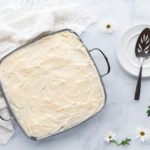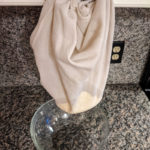Table of Contents[Hide][Show]
How to make fresh cream cheese from whole milk that can be used as a nutritious ingredient in both savory and sweet dishes.

Cream cheese is an important item in the kitchen for making dips, spreads, sauces, and desserts.
However, the highly processed versions from the store are best avoided.
Not only is the milk and cream used to make it pasteurized to the point where it is basically indigestible, but gum additives such as carob bean are also typically added to give it the natural body lost during manufacturing.
This is true even for organic brands.
These ingredients can serve as a trigger for digestive inflammation and uncomfortable symptoms for those that are sensitive.
You will be delighted to learn that making your own cream cheese is quite simple, in fact!
All you need is a quart of whole milk, fresh from the cow, and you are ready to proceed!
Find a local dairy farmer near you by checking the listings at realmilk.com
I’ve been making my own cream cheese from freshly clabbered milk for over twenty years now. Here are a few of my favorite recipes that call for cream cheese:
I also enjoy blending homemade cream cheese with strawberries and a drizzle of maple syrup for a yummy spread for sourdough bagels. It also tastes great on these low-carb, grain-free bagels.
Texture, Taste and Shelf-life
Note that the texture of cream cheese you make yourself is softer than the gum-enhanced fake versions from the store.
It also has a slight sourness typical of probiotic-rich fermented foods.
Sweetening it for cheesecake or a bagel spread eliminates this issue completely according to my taste buds. I’ve even used it to make cream cheese frosting with excellent tasting results.
This fresh cream cheese will not last as long as processed store versions. Be sure to refrigerate right after you make it and use within about a week.
If you do not have farm fresh milk available in your area, try this recipe for making cream cheese from pasteurized milk instead.

Fresh Cream Cheese Recipe
How to make fresh cream cheese from clabbered whole milk that can be used as a spread or ingredient in both savory and sweet dishes.
Instructions
-
Allow the unpasteurized milk to sit in the sealed jug on the counter for 1-3 days at room temperature. This allows the milk to separate and transform into clabber. Note that the fresher the milk and the colder the temperature of your house, the longer this will take.
-
Line a large glass bowl with a clean, white dishtowel that isn't too thick. Very fine cheesecloth will also work.
-
Gently pour the clabber into the middle of the dishtowel. Gather up the ends and fasten with a rubber band. Attach to a knob on an upper cabinet in your kitchen as shown in the picture.

-
Let the yellowish liquid portion of the clabber (liquid whey) drip into the bowl underneath. This process will continue for an hour or two.
-
After the dripping stops, gently take down the hanging bag and place it into a clean bowl. Scrape out the fresh cream cheese that is inside the bag into a container with a lid, and refrigerate.
-
Pour the liquid whey from the dripping bowl into a glass mason jar, affix the lid and refrigerate. It can be used as a probiotic starter for fermented foods or added directly to smoothies.
-
Kept refrigerated, fresh cream cheese will be good to eat for about a week.









Hi Sarah, I am a home cheesemaker, making 8 gallon batches of 35+ different cheeses, from my own raw milk from my grassfed, (in the summer) organically fed house cow. I have oodles of whey that I throw away. Could this be used from recipes like cheddar that don’t go over about 103*?
If the whey is unheated, it can be used as starter. As for making raw cheddar, I don’t know specifically as I have not tried it myself.
Hi Sarah! Thank you. How much cream cheese will this yield?
It depends on the size of the creamline of the milk. Amount will vary based on the breed of the cow, quality of the pasture etc.
I am wondering if this isn’t more of a neufchatel cheese rather than a cream cheese, being made from cream AND milk?
It’s not made from cream and milk. It’s made from whole milk. No added cream. Milk with the cream removed is skim milk, it’s not unprocessed REAL milk.
This sounds good. However, for those of us who don’t have easy access to raw milk, you can also buy cultures to inoculate pasteurized organic milk. I’ve done this many times, and it’s really easy too. In addition, the final product probably tastes closer to your store-bought cream cheese.
Yes, you can do this. However, it’s not cream cheese. What you have then is yogurt or kefir cheese. I would recommend not trying to mimic commercial cream cheese… it’s fake, just like the fake buttermilk and fake yogurt (which is cultured for an hour or so, not 24 hours as traditionally done). Big Food makes a habit of co-opting traditional food terms and making money off their synthetic stuff that pales in nutritional value and digestibility compared with the real thing. Real cream cheese is only made from self-clabbered raw milk.
https://www.thehealthyhomeeconomist.com/how-to-make-yogurt-cheese-raw-or-heated/
Hi Sarah! I have 3, half gallon jugs of 2-3 month old raw, grassfed milk that I was going to throw out. Is it too old for this and all recipes at this point? Thanks for all your help!
It’s probably too strong tasting and sour at this point. I would suggest pouring it on the garden as a natural fertilizer. It really brings in the worms!
Hi!
Would it go bad if I add salt and some garlic?
It’s fine to add AFTER clabbering and separation from the liquid whey.
Hi there, I’ve made this recipe as instructed a few times and unfortunately this cream cheese does not taste anything like store-bought. I couldn’t use it in recipes because it changes the finished taste completely. To be honest I don’t like the taste at all and it was a struggle to eat it. I wish there was a way to make it taste like store-bought.
Yes, there is more taste to homemade as it comes from milk from grassfed cows which is clabbered (self-fermented). Fermentation adds a slight sourness typical of other fermented foods. The cream cheese at the store is made from confined cows eating GMO grain…it is also not fermented.
I don’t find that it changes the taste completely, however … it even works well for cream cheese frosting.
The texture of homemade is definitely softer than the gum-enhanced solid blocks from the store.
Getting used to real cream cheese as it used to be made takes a transition period. Perhaps you could mix homemade with store bought and gradually increase the proportion of homemade as your taste buds adjust? I know of folks that do this with soaked oatmeal too as soaked oats have a slight sourness as well.
Now that I am used to homemade cream cheese, I find the store-bought highly unappealing and fake tasting. It’s all what your taste buds are used to, I think.